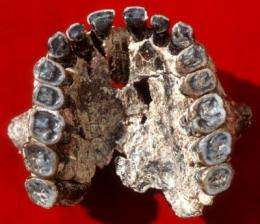Dawn of humanity illuminated in special journal edition -- 50 years after the Leakeys

The first systematic, multidisciplinary results to come out of research conducted on the edge of the Serengeti at the rich palaeoanthropological site in the Olduvai Gorge in Tanzania since that produced by Louis and Mary Leakey's team, have recently been published in a special issue of the prestigious Journal of Human Evolution.
Professor Marion Bamford, deputy director of the Bernard Price Institute for Palaeontological Research, and Professor Ron Clarke from the Institute of Human Evolution – both at the University of the Witwatersrand – contributed papers to the 191-page special edition. Bamford and Clarke's contributions are part of 15 papers by 25 scientists to have come from research conducted by the Olduvai Landscape Paleoanthropology Project (OLAPP) since 1989 and the special edition is entitled Five Decades after Zinjanthropus and Homo habilis: Landscape Paleoanthropology of Plio-Pleistocene Olduvai Gorge, Tanzania.
"The significance of this special edition is the culmination of the work we have been doing at Olduvai the past two decades and is an impressive range of articles that deals with various aspects of our distant ancestor Homo habilis."
"No one site tells us more about the last two million years of human evolution than Olduvai and with contributing researchers from Wits University, this collaborative work dispels the suppose rift in palaeosciences between East Africa and South Africa," says Professor Robert Blumenschine, guest-editor of the special edition and Chief Scientific Strategist of the Palaeontological Scientific Trust (PAST), based at Wits.
Bamford and Clarke are also associated with and supported by PAST which provides funding to members of the OLAPP team, including to the local excavators and technicians supporting the research in Tanzania.
"The publication celebrates the 50th anniversary of the Leakey-discoveries in 1959 and 1960 of the Zinjanthropus (now known as Paranthropus boisei) and Homo habilis type species. The Leakey's work, spanning five decades until 1984, established Olduvai as the single most important record for hominid biological and technological evolution over the last two million years," Blumenschine says.
Bamford's paper entitled Fossil sedges, microplants, and roots from Olduvai Gorge, Tanzania, and her collaborative paper with Rosa Albert entitled Vegetation during UMBI and deposition of Tuff IF at Olduvai Gorge, Tanzania (ca. 1.8 Ma) based on phytoliths and plant remains, provide the first systematic report of plant fossils from Olduvai. Together, these papers show the great potential plant fossils hold for high resolution palaeoenvironmental reconstruction of the habitats used by Homo habilis at Olduvai.
Clarke, who has worked closely with the Leakeys in the 1960s, gives in his paper entitled A Homo habilis maxilla and other newly-discovered hominid fossils from Olduvai Gorge, Tanzania, a full description of the Olduvai Hominid (OH) 65 palate, the first complete upper dentition of Homo habilis. This specimen provides crucial evidence for redefining Homo habilis.
Clarke also describes the specimen OH 7X, that is the previously missing right second molar of the OH 7 mandible discovered by the Leakeys 46 years earlier, and used by them to originally describe the species Homo habilis.
More information: To view the special issue, visit www.journals.elsevier.com/jour … olution/#description
Journal information: Journal of Human Evolution
Provided by Wits University




















